形容词搭配不定式
- 格式:doc
- 大小:44.00 KB
- 文档页数:1
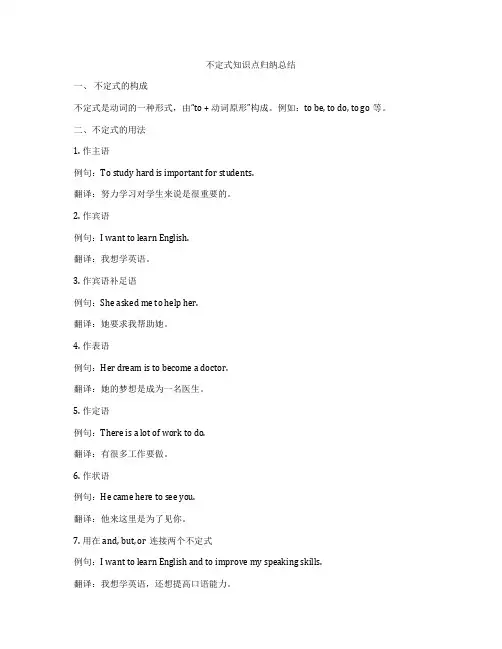
不定式知识点归纳总结一、不定式的构成不定式是动词的一种形式,由“to + 动词原形”构成。
例如:to be, to do, to go等。
二、不定式的用法1. 作主语例句:To study hard is important for students.翻译:努力学习对学生来说是很重要的。
2. 作宾语例句:I want to learn English.翻译:我想学英语。
3. 作宾语补足语例句:She asked me to help her.翻译:她要求我帮助她。
4. 作表语例句:Her dream is to become a doctor.翻译:她的梦想是成为一名医生。
5. 作定语例句:There is a lot of work to do.翻译:有很多工作要做。
6. 作状语例句:He came here to see you.翻译:他来这里是为了见你。
7. 用在and, but, or连接两个不定式例句:I want to learn English and to improve my speaking skills.翻译:我想学英语,还想提高口语能力。
8. 与形容词和副词连用例句:I'm happy to meet you.翻译:见到你我很高兴。
9. 用在名词前表示目的,结果等例句:He gave us some advice to help us study better. 翻译:他给了我们一些建议,帮助我们更好地学习。
三、不定式的特殊用法1. with + 宾语 + 不定式例句:He left me with nothing to say.翻译:他让我无话可说。
2. for + 宾语 + to 不定式例句:We have a lot of work for you to do.翻译:我们有很多工作需要你做。
3. 不定式的被动形式例句:The book is difficult to finish.翻译:这本书难以完成。

高中英语动词不定式的基本用法1. 什么是动词不定式?动词不定式是动词的一种形式,在句中充当名词、形容词或副词。
它通常由“to”加上动词原形构成。
例如:to eat、to sleep、to study。
2. 动词不定式作名词动词不定式作名词时,可以做主语、宾语、表语或宾补。
- 作主语:To travel is my dream.- 作宾语:I want to learn English.- 作宾补:She asked me to help her.3. 动词不定式作形容词动词不定式作形容词时,通常修饰名词或代词。
- 修饰名词:I have a book to read.- 修饰代词:There is nothing to worry about.4. 动词不定式作副词动词不定式作副词时,通常修饰动词、形容词或副词。
- 修饰动词:She went to the park to play.- 修饰形容词:He is too tired to continue.- 修饰副词:She runs fast to catch the bus.5. 动词不定式与其他句型的搭配动词不定式与其他句型可以有不同的搭配方式。
- 动词不定式与情态动词搭配:I can't wait to see you.- 动词不定式与感官动词搭配:I heard him sing.- 动词不定式与使役动词搭配:She made me clean the room.6. 动词不定式的否定形式动词不定式的否定形式是在“to”前加“not”,构成“not to + 动词原形”。
- I decided not to go to the party.7. 动词不定式的完成式动词不定式的完成式是在“to”前加“have”,再加动词的过去分词形式。
- I'm glad to have met you.以上就是关于高中英语动词不定式的基本用法的完整版,希望能对您有所帮助。
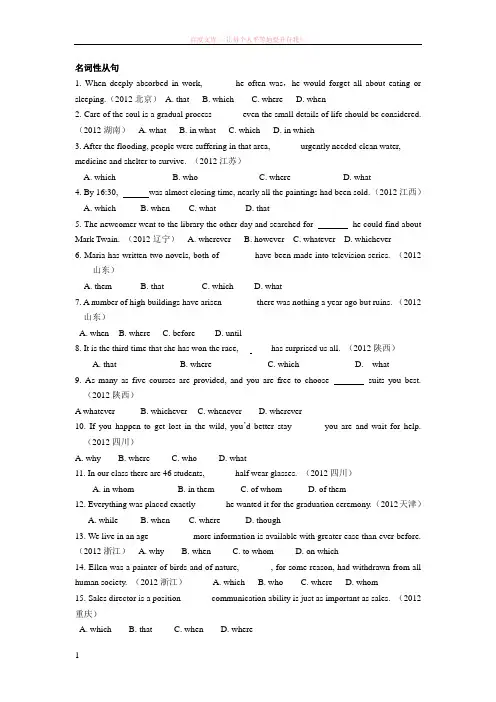
名词性从句1. When deeply absorbed in work, ______ he often was,he would forget all about eating or sleeping.(2012北京)A. that B. which C. where D. when2. Care of the soul is a gradual process ______ even the small details of life should be considered. (2012湖南) A. what B. in what C. which D. in which3. After the flooding, people were suffering in that area, ______ urgently needed clean water, medicine and shelter to survive. (2012江苏)A. whichB. whoC. whereD. what4. By 16:30, was almost closing time, nearly all the paintings had been sold. (2012江西)A. whichB. whenC. whatD. that5. The newcomer went to the library the other day and searched for he could find about Mark Twain. (2012辽宁) A. wherever B. however C. whatever D. whichever6. Maria has written two novels, both of _______ have been made into television series. (2012山东)A. themB. thatC. whichD. what7. A number of high buildings have arisen _______ there was nothing a year ago but ruins. (2012山东)A. whenB. whereC. beforeD. until8. It is the third time that she has won the race, __ ____ has surprised us all. (2012陕西)A. thatB. whereC. whichD. what9. As many as five courses are provided, and you are free to choose suits you best. (2012陕西)A whatever B. whichever C. whenever D. wherever10. If you happen to get lost in the wild, you’d better stay ______ you are and wait for help. (2012四川)A. whyB. whereC. whoD. what11. In our class there are 46 students, ______ half wear glasses. (2012四川)A. in whomB. in themC. of whomD. of them12. Everything was placed exactly ______ he wanted it for the graduation ceremony. (2012天津)A. whileB. whenC. whereD. though13. We live in an age ______ more information is available with greater ease than ever before. (2012浙江) A. why B. when C. to whom D. on which14. Ellen was a painter of birds and of nature, ______ , for some reason, had withdrawn from all human society. (2012浙江) A. which B. who C. where D. whom15. Sales director is a position ______ communication ability is just as important as sales. (2012重庆)A. whichB. thatC. whenD. where16. Evidence has been found through years of study ______ children’s early sleeping problem likely to continue when they grow up. (2012重庆)A. whyB. howC. whetherD. that17. That evening, ______ I will tell you more about later, I ended up working very late. (2012全国卷2)A. thatB. whichC. what D.when动词不定式做定语1)主动关系He was the last guest to arrive(=who arrived)He is not the man to draw back.2) 动宾关系He has a large family to support(=that he must support)This is the best book to read.There is a quarter of an hour to kill.3) 同位关系The boy has an impulse to jump over the fense.I have no wish to quarrel with you.不定式与形容词的搭配关系:1)主句主语是不定式结构的逻辑主语a.表示喜怒哀惧的形容词+不定式He is glad to help each otherHenry was happy to heard it=Henry was happy when he heard it.We were sorry not to be there.John was very pleased to be given the job.b)表示运气好坏的形容词+不定式He was lucky to find it.She was unlucky to spoil it.c)表示心理状态,个人态度的形容词He is anxious to see her?He is not very keen to think about it.We are ready to make the attempt.d)表示性格特征和行为表现的形容词+不定式He is foolish to meet her again.They were thoughtful to come home early.She was stupid to make such a mistake.You are kind to say so.2)主句主语是不定式结构的逻辑宾语。

todo不定式用法"to do" 不定式是英语中的一种不定式结构,通常以"to" 开头,后面紧跟动词原形。
在这个结构中,"to" 被称为不定式符号,而不定式本身则可以用作名词、形容词或副词。
以下是"to do" 不定式的常见用法:1. 作为动词的不定式(动词不定式):•作为动词,"to do" 表示一个动作或状态的概念。
•例如:•I want to do my homework.(我想做我的家庭作业。
)•She needs to finish the project.(她需要完成这个项目。
)2. 作为名词的不定式(不定式名词):•"to do" 不定式可以作为名词使用,表示一个抽象的动作或概念。
•例如:•To swim is my favorite activity.(游泳是我最喜欢的活动。
)•She enjoys reading books. To read is her hobby.(她喜欢读书。
阅读是她的爱好。
)3. 作为形容词的不定式(不定式形容词):•"to do" 不定式可以用作形容词,修饰一个名词。
•例如:•This is the best book to read.(这是最好的一本书,适合阅读。
)4. 作为副词的不定式(不定式副词):•"to do" 不定式可以用作副词,修饰动词、形容词或副词。
•例如:•She works hard to succeed.(她努力工作以取得成功。
)•The water is too hot to drink.(水太烫,不能喝。
)需要注意的是,有一些常见的动词后面直接接不定式,而无需"to"。
这些动词包括"make," "let," "help," "watch," 等。

史上最完整的动词不定式用法规律知识点总结动词不定式是英语中的一种非谓语动词形式。
它可以充当名词、形容词或副词,具有广泛的用途和特定的语法规则。
本文将为您总结史上最完整的动词不定式用法规律知识点,帮助您更好地理解和运用这一语法结构。
一、动词不定式的基本结构动词不定式由“to + 动词原形”构成,例如:to study、to eat、to sleep 等。
它可以作为名词、形容词或副词在句子中进行修饰或起其他功能。
二、动词不定式作为名词动词不定式可以作为名词在句子中担任主语、宾语、表语、同位语等。
1. 作主语:To learn a foreign language is beneficial.学习一门外语是有益的。
2. 作宾语:She wants to go shopping.她想去购物。
3. 作表语:His dream is to become a doctor.他的梦想是成为一名医生。
4. 作同位语:His goal, to win the championship, motivates him to practice every day.为了赢得冠军,他每天都在努力。
三、动词不定式作为形容词动词不定式可以作为形容词修饰名词,通常在名词之前。
1. 修饰名词:I have a book to read.我有一本要读的书。
2. 修饰人:She is the person to ask for help.她是可以求助的人。
四、动词不定式作为副词动词不定式可以作为副词修饰动词、形容词或副词,表示目的、结果、原因等。
1. 修饰动词:He bought a new computer to play games.他买了一台新电脑来玩游戏。
2. 修饰形容词:She is too tired to continue working.她太累了,无法继续工作。
3. 修饰副词:He speaks English fluently enough to communicate with foreigners.他的英语说得足够流利,可以与外国人交流。
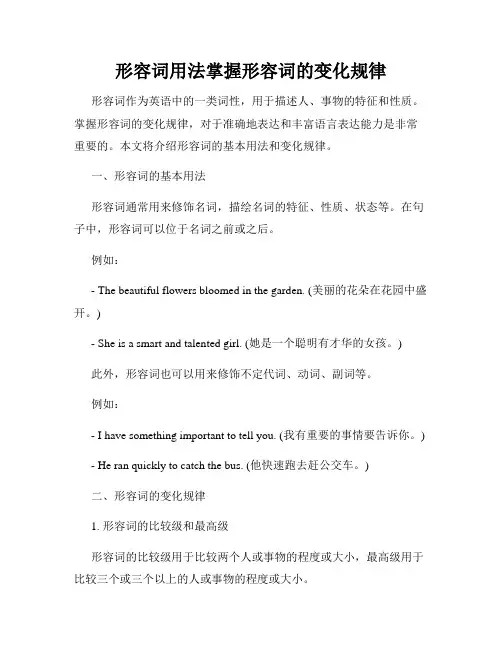
形容词用法掌握形容词的变化规律形容词作为英语中的一类词性,用于描述人、事物的特征和性质。
掌握形容词的变化规律,对于准确地表达和丰富语言表达能力是非常重要的。
本文将介绍形容词的基本用法和变化规律。
一、形容词的基本用法形容词通常用来修饰名词,描绘名词的特征、性质、状态等。
在句子中,形容词可以位于名词之前或之后。
例如:- The beautiful flowers bloomed in the garden. (美丽的花朵在花园中盛开。
)- She is a smart and talented girl. (她是一个聪明有才华的女孩。
)此外,形容词也可以用来修饰不定代词、动词、副词等。
例如:- I have something important to tell you. (我有重要的事情要告诉你。
) - He ran quickly to catch the bus. (他快速跑去赶公交车。
)二、形容词的变化规律1. 形容词的比较级和最高级形容词的比较级用于比较两个人或事物的程度或大小,最高级用于比较三个或三个以上的人或事物的程度或大小。
一般情况下,形容词的比较级在原形后面加上-er,最高级在原形后面加上-est。
例如:- This shirt is cheaper than that one. (这件衬衫比那件便宜。
)- She is the tallest girl in her class. (她是班里最高的女孩。
)但是,也有一些形容词的比较级和最高级形式有不规则变化。
例如:- good(好)- better(更好)- best(最好)- bad(坏)- worse(更差)- worst(最差)2. 形容词的属格形式当形容词用来表达名词的所属关系时,需使用属格形式。
一般情况下,在形容词后面加上-apostrophe+s。
例如:- John's car is very fast. (约翰的车很快。
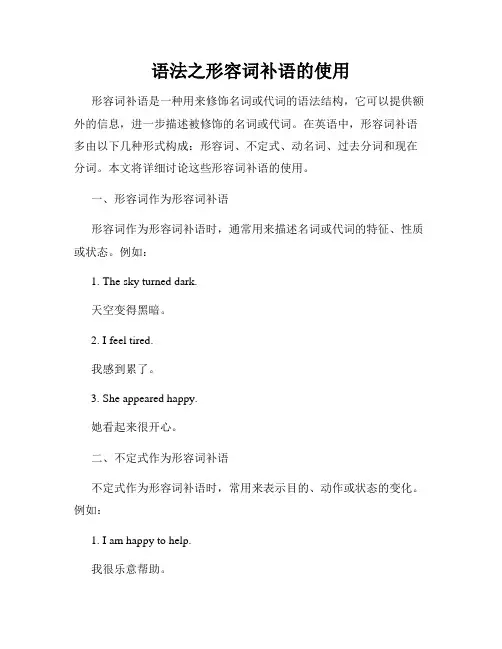
语法之形容词补语的使用形容词补语是一种用来修饰名词或代词的语法结构,它可以提供额外的信息,进一步描述被修饰的名词或代词。
在英语中,形容词补语多由以下几种形式构成:形容词、不定式、动名词、过去分词和现在分词。
本文将详细讨论这些形容词补语的使用。
一、形容词作为形容词补语形容词作为形容词补语时,通常用来描述名词或代词的特征、性质或状态。
例如:1. The sky turned dark.天空变得黑暗。
2. I feel tired.我感到累了。
3. She appeared happy.她看起来很开心。
二、不定式作为形容词补语不定式作为形容词补语时,常用来表示目的、动作或状态的变化。
例如:1. I am happy to help.我很乐意帮助。
2. The cake is ready to eat.这个蛋糕可以吃了。
3. He is eager to learn.他渴望学习。
三、动名词作为形容词补语动名词作为形容词补语时,通常用来描述名词或代词的功能、用途或特性。
例如:1. She is good at painting.她擅长绘画。
2. I am interested in reading.我对阅读感兴趣。
3. They are busy repairing the car.他们正忙于修理车子。
四、过去分词作为形容词补语过去分词作为形容词补语时,通常用来描述被动、完成或变化的结果。
例如:1. The book was written by a famous author.这本书是由一位著名作家写的。
2. The broken glass should be handled with care.这块破碎的玻璃应该小心处理。
3. The stolen wallet has been returned to its owner.被偷的钱包已经归还给了它的主人。
五、现在分词作为形容词补语现在分词作为形容词补语时,常用来描述主语的状态、特征或起因。
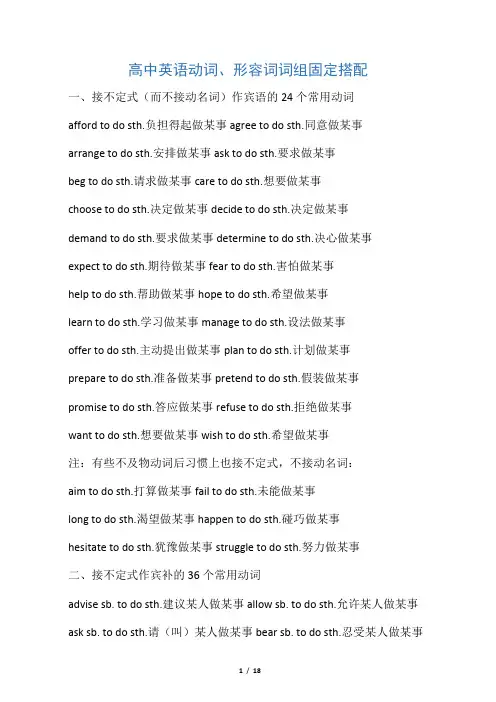
高中英语动词、形容词词组固定搭配一、接不定式(而不接动名词)作宾语的24个常用动词afford to do sth.负担得起做某事agree to do sth.同意做某事arrange to do sth.安排做某事ask to do sth.要求做某事beg to do sth.请求做某事care to do sth.想要做某事choose to do sth.决定做某事decide to do sth.决定做某事demand to do sth.要求做某事determine to do sth.决心做某事expect to do sth.期待做某事fear to do sth.害怕做某事help to do sth.帮助做某事hope to do sth.希望做某事learn to do sth.学习做某事manage to do sth.设法做某事offer to do sth.主动提出做某事plan to do sth.计划做某事prepare to do sth.准备做某事pretend to do sth.假装做某事promise to do sth.答应做某事refuse to do sth.拒绝做某事want to do sth.想要做某事wish to do sth.希望做某事注:有些不及物动词后习惯上也接不定式,不接动名词:aim to do sth.打算做某事fail to do sth.未能做某事long to do sth.渴望做某事happen to do sth.碰巧做某事hesitate to do sth.犹豫做某事struggle to do sth.努力做某事二、接不定式作宾补的36个常用动词advise sb. to do sth.建议某人做某事allow sb. to do sth.允许某人做某事ask sb. to do sth.请(叫)某人做某事bear sb. to do sth.忍受某人做某事beg sb. to do sth.请求某人做某事cause sb. to do sth.导致某人做某事command sb. to do sth.命令某人做某事drive sb. to do sth .驱使某人做某事elect sb. to do sth.选举某人做某事encourage sb. to do sth.鼓励某人做某事expect sb. to do sth.期望某人做某事forbid sb. to do sth.禁止某人做某事force sb. to do sth.强迫某人做某事get sb. to do sth.使(要)某人做某事hate sb. to do sth.讨厌某人做某事help sb. to do sth.帮助某人做某事intend sb. to do sth.打算要某人做某事invite sb. to do sth.邀请某人做某事leave sb. to do sth.留下某人做某事like sb. to do sth.喜欢某人做某事mean sb. to do sth.打算要某人做某事need sb. to do sth.需要某人做某事oblige sb. to do sth.迫使某人做某事order sb. to do sth.命令某人做某事permit sb. to do sth.允许某人做某事persuade sb. to do sth.说服某人做某事prefer sb. to do sth.宁愿某人做某事request sb. to do sth.要求某人做某事remind sb. to do sth.提醒某人做某事teach sb. to do sth .教某人做某事tell sb. to do sth.告诉某人做某事train sb. to do sth.训练某人做某事trouble sb. to do sth.麻烦某人做某事want sb. to do sth.想要某人做某事warn sb. to do sth.警告某人做某事wish sb. to do sth.希望某人做某事注:不要受汉语意思的影响而误用以下动词句型:汉语说:“害怕某人做某事”,但英语不说fear sb. to do sth.。
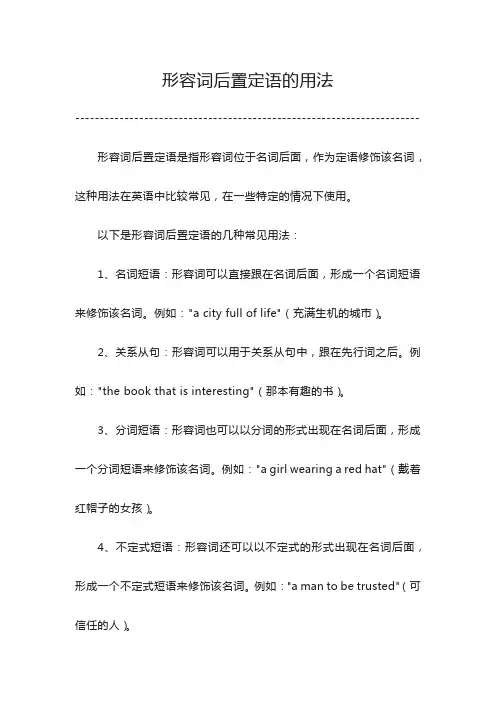
形容词后置定语的用法
---------------------------------------------------------------------- 形容词后置定语是指形容词位于名词后面,作为定语修饰该名词,这种用法在英语中比较常见,在一些特定的情况下使用。
以下是形容词后置定语的几种常见用法:
1、名词短语:形容词可以直接跟在名词后面,形成一个名词短语来修饰该名词。
例如:"a city full of life"(充满生机的城市)。
2、关系从句:形容词可以用于关系从句中,跟在先行词之后。
例如:"the book that is interesting"(那本有趣的书)。
3、分词短语:形容词也可以以分词的形式出现在名词后面,形成一个分词短语来修饰该名词。
例如:"a girl wearing a red hat"(戴着红帽子的女孩)。
4、不定式短语:形容词还可以以不定式的形式出现在名词后面,形成一个不定式短语来修饰该名词。
例如:"a man to be trusted"(可信任的人)。
需要注意的是,形容词后置定语的使用要根据具体的语境和表达需求来确定。
在一般情况下,形容词通常位于名词前面,但在特定的语言习惯或修辞手法中,形容词后置定语可以产生更加准确、具体或生动的表达效果。
此外,在英语写作中,要注意避免形容词后置定语过长或过于复杂,以保持句子的清晰和易读性。
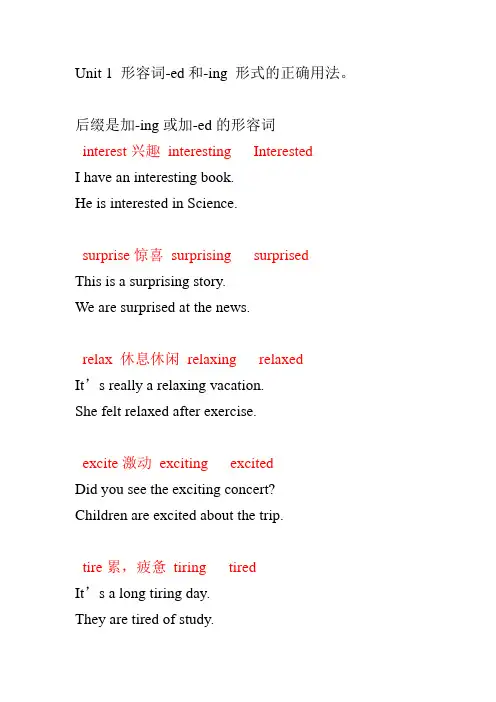
矿产资源开发利用方案编写内容要求及审查大纲
矿产资源开发利用方案编写内容要求及《矿产资源开发利用方案》审查大纲一、概述
㈠矿区位置、隶属关系和企业性质。
如为改扩建矿山, 应说明矿山现状、
特点及存在的主要问题。
㈡编制依据
(1简述项目前期工作进展情况及与有关方面对项目的意向性协议情况。
(2 列出开发利用方案编制所依据的主要基础性资料的名称。
如经储量管理部门认定的矿区地质勘探报告、选矿试验报告、加工利用试验报告、工程地质初评资料、矿区水文资料和供水资料等。
对改、扩建矿山应有生产实际资料, 如矿山总平面现状图、矿床开拓系统图、采场现状图和主要采选设备清单等。
二、矿产品需求现状和预测
㈠该矿产在国内需求情况和市场供应情况
1、矿产品现状及加工利用趋向。
2、国内近、远期的需求量及主要销向预测。
㈡产品价格分析
1、国内矿产品价格现状。
2、矿产品价格稳定性及变化趋势。
三、矿产资源概况
㈠矿区总体概况
1、矿区总体规划情况。
2、矿区矿产资源概况。
3、该设计与矿区总体开发的关系。
㈡该设计项目的资源概况
1、矿床地质及构造特征。
2、矿床开采技术条件及水文地质条件。
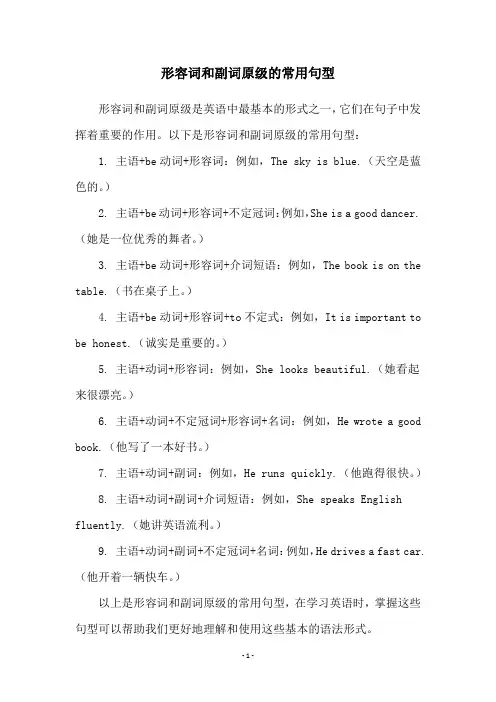
形容词和副词原级的常用句型
形容词和副词原级是英语中最基本的形式之一,它们在句子中发挥着重要的作用。
以下是形容词和副词原级的常用句型:
1. 主语+be动词+形容词:例如,The sky is blue.(天空是蓝色的。
)
2. 主语+be动词+形容词+不定冠词:例如,She is a good dancer.(她是一位优秀的舞者。
)
3. 主语+be动词+形容词+介词短语:例如,The book is on the table.(书在桌子上。
)
4. 主语+be动词+形容词+to不定式:例如,It is important to be honest.(诚实是重要的。
)
5. 主语+动词+形容词:例如,She looks beautiful.(她看起来很漂亮。
)
6. 主语+动词+不定冠词+形容词+名词:例如,He wrote a good book.(他写了一本好书。
)
7. 主语+动词+副词:例如,He runs quickly.(他跑得很快。
)
8. 主语+动词+副词+介词短语:例如,She speaks English fluently.(她讲英语流利。
)
9. 主语+动词+副词+不定冠词+名词:例如,He drives a fast car.(他开着一辆快车。
)
以上是形容词和副词原级的常用句型,在学习英语时,掌握这些句型可以帮助我们更好地理解和使用这些基本的语法形式。
英语不定式知识点归纳一、不定式的形式不定式的基本形式是“to +动词原形”,如“to study”“to play”。
但有时也会省略“to”,这种情况被称为不带“to”的不定式,比如在使役动词(make, let, have)和感官动词(see, hear, watch, notice 等)之后作宾语补足语时,就会使用不带“to”的不定式。
二、不定式的作用1、作主语不定式作主语时,通常被视为一个比较正式的表达方式,常放在句首。
但由于主语太长会使句子显得头重脚轻,所以常用“it”作形式主语,把真正的主语——不定式短语放在后面。
例如:“To learn English wellis not easy” 可转换为“It is not easy to learn English well”2、作宾语一些动词后面常接不定式作宾语,比如“want”“hope”“decide”“agree”“refuse”等。
例如:“I want to go shopping this weekend”3、作宾语补足语如前面提到的,使役动词和感官动词后面常接不定式作宾语补足语。
例如:“The boss made the workers work long hours” “I saw him play football yesterday”4、作定语不定式作定语时,通常放在被修饰的名词或代词之后。
例如:“I have a lot of work to do” “There is no time to waste”5、作状语不定式可以作目的状语、结果状语等。
例如:“He ca me here to see me” (目的状语)“He is too young to go to school” (结果状语)三、不定式的时态和语态1、时态不定式有时态的变化,一般式(to do)表示动作与谓语动词同时发生或在其后发生;进行式(to be doing)表示动作正在进行,与谓语动词的动作同时发生;完成式(to have done)表示动作发生在谓语动词之前。
动词不定式的结构和用法动词不定式是英语中一种常见的语法结构,通常由"to"加上动词的原形构成。
它可以在句子中充当名词、形容词或副词的角色,并且具有多种用法。
1. 作为名词不定式可以作为名词,在句子中充当主语、宾语或表语。
例如:- 主语:To learn a foreign language is beneficial.- 宾语:They want to visit China.不定式作为名词时,常常出现在以下固定搭配中:- It's + adj. + to-infinitive:To travel is exciting.- It's + adj. + for sb. + to-infinitive:It's important for us to protect the environment.2. 作为形容词不定式也可用作形容词,修饰名词。
例如:- She has a book to read.- I have a question to ask.在这种用法中,不定式可以表示目的、原因或结果。
常见的固定搭配有:- adj. + enough + to-infinitive:He is old enough to drive.- too + adj. + to-infinitive:The problem was too difficult to solve.3. 作为副词不定式还可以作为副词,修饰动词、形容词或副词。
例如:- She worked hard to pass the exam.- He ran fast to catch the bus.不定式作为副词时,可以表示目的、结果、方式或条件。
4. 其他用法除了上述三种常见用法外,不定式还有一些其他用法,如下所示:- 不定式作宾语补足语:I want you to help me.- 不定式引导目的状语从句:I came here to see you.- 不定式构成复合宾语:She made him study.- 不定式构成条件状语从句:To succeed, you need to work hard.总结起来,动词不定式的结构和用法多种多样。
词语搭配知识点总结大全一、名词搭配1. 时间名词搭配:morning routine(早晨例行公事)、afternoon nap(下午小睡)、evening walk(晚上散步)2. 形容词搭配:beautiful scenery(美丽的风景)、delicious food(美味的食物)、interesting book(有趣的书籍)3. 动词搭配:take a shower(冲凉)、do homework(做作业)、go fishing(去钓鱼)4. 名词+动词搭配:coffee break(喝咖啡休息)、job interview(工作面试)、birthdayparty(生日派对)5. 名词+形容词搭配:happy family(幸福的家庭)、warm sunshine(暖暖的阳光)、green grass(翠绿的草地)6. 名词+名词搭配:rainy season(雨季)、coffee shop(咖啡店)、bus station(公交车站)7. 名词+副词搭配:school bus(校车)、summer camp(夏令营)、dance party(舞会)8. 名词+介词搭配:bird in the sky(天空中的鸟)、book on the table(桌上的书)、flower in the garden(花园里的花)9. 名词+连词搭配:cup and saucer(杯子和茶碟)、fish and chips(炸鱼薯条)、you andme(你和我)10. 名词+数词搭配:ten students(十个学生)、three cars(三辆车)、five books(五本书)二、动词搭配1. 动词+名词搭配:make a decision(做决定)、take a walk(散步)、have a chat(聊天)2. 动词+形容词搭配:feel tired(感到疲倦)、look beautiful(看起来漂亮)、sound interesting(听起来有趣)3. 动词+动词搭配:go hiking(去徒步旅行)、finish reading(完成阅读)、start running(开始跑步)4. 动词+副词搭配:talk loudly(大声说话)、eat quickly(吃得快)、drive carefully(小心驾驶)5. 动词+介词搭配:wait for(等待)、listen to(听)、talk about(谈论)6. 动词+连词搭配:wash and dry(洗干净)、stop and go(停下来然后继续)、sit andstand(坐下来然后站起来)7. 动词+数词搭配:run five miles(跑五英里)、drink two cups of coffee(喝两杯咖啡)、read ten books(读十本书)8. 动词+情态动词搭配:can do(能做)、may go(可能去)、should study(应该学习)9. 动词+虚拟语气搭配:would like(想要)、could help(可能帮忙)、should have(应该有)10. 动词+不定式搭配:decide to go(决定去)、want to learn(想要学习)、try to do(尝试做)三、形容词搭配1. 形容词+名词搭配:tired eyes(疲倦的眼睛)、beautiful flowers(美丽的花朵)、cold weather(寒冷的天气)2. 形容词+形容词搭配:tall and slim(高高瘦瘦)、beautiful and intelligent(漂亮又聪明)、hot and humid(炎热潮湿)3. 形容词+动词搭配:happy to see(高兴见到)、angry at(生气)、excited about(对…感到兴奋)4. 形容词+副词搭配:very happy(非常高兴)、extremely fast(极快)、quite interesting(相当有趣)5. 形容词+介词搭配:fond of(喜欢)、proud of(自豪)、afraid of(害怕)6. 形容词+连词搭配:slow but steady(缓慢但稳定)、serious and responsible(严肃而负责)、kind and caring(善良而关心)7. 形容词+数词搭配:many happy(很多快乐)、few friends(少数朋友)、someinteresting(一些有趣)8. 形容词+情态动词搭配:can do(能做)、may go(可能去)、should study(应该学习)9. 形容词+虚拟语气搭配:would like(想要)、could help(可能帮忙)、should have(应该有)10. 形容词+不定式搭配:beautiful to see(美丽的景色)、hard to believe(难以置信)、easyto understand(容易理解)四、副词搭配1. 副词+名词搭配:very early(非常早)、quite late(相当晚)、extremely high(极高)2. 副词+形容词搭配:very happy(非常高兴)、extremely fast(极快)、quite interesting(相当有趣)3. 副词+动词搭配:eat quickly(吃得快)、run slowly(跑得慢)、drive carefully(小心驾驶)4. 副词+副词搭配:very quickly(非常快)、quite slowly(相当慢)、extremely carefully(非常小心)5. 副词+连词搭配:so but(如此但是)、however yet(然而但是)、nevertheless also(然而也)6. 副词+数词搭配:quite a few(相当多)、very little(非常少)、so many(如此多)7. 副词+情态动词搭配:can do(能做)、may go(可能去)、should study(应该学习)8. 副词+虚拟语气搭配:would like(想要)、could help(可能帮忙)、should have(应该有)9. 副词+不定式搭配:easy to understand(容易理解)、hard to believe(难以置信)、quicklyto finish(快速完成)五、数词搭配1. 数词+名词搭配:ten students(十个学生)、three cars(三辆车)、five books(五本书)2. 数词+形容词搭配:many happy(很多快乐)、few friends(少数朋友)、someinteresting(一些有趣)3. 数词+副词搭配:quite a few(相当多)、very little(非常少)、so many(如此多)4. 数词+动词搭配:run five miles(跑五英里)、drink two cups of coffee(喝两杯咖啡)、read ten books(读十本书)5. 数词+介词搭配:one of(其中之一)、two of(其中两个)、three of(其中三个)6. 数词+连词搭配:one and two(一和二)、three or four(三或四)、five but six(五但是六)7. 数词+情态动词搭配:can do(能做)、may go(可能去)、should study(应该学习)8. 数词+虚拟语气搭配:would like(想要)、could help(可能帮忙)、should have(应该有)9. 数词+不定式搭配:quickly to finish(快速完成)、easy to understand(容易理解)、hard to believe(难以置信)六、连词搭配1. 连词+名词搭配:cup and saucer(杯子和茶碟)、fish and chips(炸鱼薯条)、you andme(你和我)2. 连词+形容词搭配:slow but steady(缓慢但稳定)、serious and responsible(严肃而负责)、kind and caring(善良而关心)3. 连词+动词搭配:wash and dry(洗干净)、stop and go(停下来然后继续)、sit andstand(坐下来然后站起来)4. 连词+副词搭配:so but(如此但是)、however yet(然而但是)、nevertheless also(然而也)5. 连词+介词搭配:on and off(断断续续)、in and out(进进出出)、up and down(上上下下)6. 连词+连词搭配:both and(既…又)、either or(要么…要么)、neither nor(既不…也不)7. 连词+数词搭配:one and two(一和二)、three or four(三或四)、five but six(五但是六)8. 连词+情态动词搭配:can do(能做)、may go(可能去)、should study(应该学习)9. 连词+虚拟语气搭配:would like(想要)、could help(可能帮忙)、should have(应该有)10. 连词+不定式搭配:to do and to be(做和成为)、to have and to hold(拥有和保持)、to see and to hear(看见和听见)七、介词搭配1. 介词+名词搭配:bird in the sky(天空中的鸟)、book on the table(桌上的书)、flower in the garden(花园里的花)2. 介词+形容词搭配:fond of(喜欢)、proud of(自豪)、afraid of(害怕)3. 介词+动词搭配:wait for(等待)、listen to(听)、talk about(谈论)4. 介词+副词搭配:up and down(上上下下)、over and under(上下)、inside andoutside(内外)5. 介词+连词搭配:both and(既…又)、either or(要么…要么)、neither nor(既不…也不)6. 介词+数词搭配:one of(其中之一)、two of(其中两个)、three of(其中三个)7. 介词+情态动词搭配:can do(能做)、may go(可能去)、should study(应该学习)8. 介词+虚拟语气搭配:would like(想要)、could help(可能帮忙)、should have(应该有)9. 介词+不定式搭配:to do and to be(做和成为)、to have and to hold(拥有和保持)、to see and to hear(看见和听见)八、情态动词搭配1. 情态动词+名词搭配:can do(能做)、may go(可能去)、should study(应该学习)2. 情态动词+形容词搭配:can help(能帮)、may know(可能知道)、should be(应该是)3. 情态动词+动词搭配:can do(能做)、may go(可能去)、should study(应该学习)4. 情态动词+副词搭配:can do(能做)、may go(可能去)、should study(应该学习)5. 情态动词+连词搭配:can and may(能和可能)、should but must(应该但必须)、would or could(愿意或可能)6. 情态动词+数词搭配:can do(能做)、may go(可能去)、should study(应该学习)7. 情态动词+虚拟语气搭配:would like(想要)、could help(可能帮忙)、should have(应该有)8. 情态动词+不定式搭配:can do(能做)、may go(可能去)、should study(应该学习)九、虚拟语气搭配1. 虚拟语气+名词搭配:would like(想要)、could help(可能帮忙)、should have(应该有)2. 虚拟语气+形容词搭配:would be(可能是)、could feel(可能感觉)、should look(应该看)3. 虚拟语气+动词搭配:would like(想要)、could help(可能帮忙)、should have(应该有)4. 虚拟语气+副词搭配:would like(想要)、could help(可能帮忙)、should have(应该有)5. 虚拟语气+连词搭配:would and could(愿意和可能)、should or might(应该或可能)、would but may(想要但可能)6. 虚拟语气+数词搭配:would like(想要)、could help(可能帮忙)、should have(应该有)7. 虚拟语气+情态动词搭配:would like(想要)、could help(可能帮忙)、should have(应该有)8. 虚拟语气+不定式搭配:would like(想要)、could help(可能帮忙)、should have(应该有)、十、不定式搭配1. 不定式+名词搭配:to do and to be(做和成为)、to have and to hold(拥有和保持)、to see and to hear(看见和听见)2. 不定式+形容词搭配:to be happy(快乐)、to feel tired(感到疲倦)、to get ready(准备好)3. 不定式+动词搭配:to do and to be(做和成为)、to have and to hold(拥有和保持)、to see and to hear(看见和听见)4. 不定式+副词搭配:to do and to be(做和。
不定式的三种基本用法总结不定式作为一种非谓语动词形式,在英语中具有广泛的用法。
总的来说,不定式有三种基本用法:作为动词的动词不定式、作为名词的名词不定式以及作为形容词或副词的形容词或副词不定式。
以下将详细介绍这三种基本用法。
1. 动词的动词不定式动词的动词不定式用于包括疑问词在内的多种动词后,如suggest、want、hope等。
动词的动词不定式一般由to加上动词的原形构成,不定式可以作主语、宾语、宾语补足语等。
例如:- I want to go to the beach.(我想要去海滩。
)- 不定式作宾语- To travel is my dream.(旅行是我的梦想。
)- 不定式作主语- He asked me to help him.(他要求我帮助他。
)- 不定式作宾语补足语2. 名词的名词不定式名词的名词不定式可以作为名词的主语、宾语、表语等。
名词不定式常出现在某些特定词组中,如agree to、decide to、hope to等。
名词不定式以to加上动词的原形形式构成。
例如:- My goal is to learn a new language.(我的目标是学习一门新语言。
)- 不定式作表语- It is important to finish the project on time.(按时完成这个项目是很重要的。
)- 不定式作表语- I have a desire to travel the world.(我有一个想要环游世界的愿望。
)- 不定式作定语3. 形容词或副词的形容词或副词不定式形容词或副词不定式修饰名词或代词,起到形容词或副词的作用。
形容词或副词不定式通常位于被修饰的名词或代词之后,并以to加上动词的原形构成。
例如:- She is happy to help.(她乐意帮忙。
)- 不定式修饰形容词- It is difficult to understand.(这很难理解。
动词不定式的固定搭配动词不定式是英语语法中的一个重要部分,它由to加上动词原形构成。
在句子中,动词不定式可以用来充当动词、名词、形容词或副词。
而在某些情况下,动词不定式还可以固定搭配使用,这些固定搭配在日常英语表达中非常常见且具有特殊的用法。
本文将为您介绍一些常见的动词不定式固定搭配。
1. 为了表示目的为了表示目的,我们可以使用动词不定式作为动词的宾语。
下面是一些常见的表示目的的动词不定式固定搭配:- to learn: 学习e.g. I go to school every day to learn new things.- to understand: 理解e.g. He listens carefully to understand the teacher's instructions.- to improve: 提高e.g. She practices playing the piano every day to improve her skills.2. 为了表示意愿或意图当我们想要表达自己的意愿或意图时,常常使用动词不定式。
以下是一些常见的动词不定式固定搭配:- to want: 想要e.g. I want to travel around the world someday.- to hope: 希望e.g. They hope to win the championship this year.- to plan: 计划e.g. We plan to go hiking during the summer vacation.3. 为了表示能力或能力不足当我们想要表达自己或他人的能力或能力不足时,可以使用动词不定式。
以下是一些常见的动词不定式固定搭配:- to be able to: 能够e.g. She is able to speak three languages fluently.- to fail to: 未能e.g. They failed to finish the project on time.- to hesitate to: 犹豫e.g. He hesitated to jump into the cold water.4. 为了表示喜好或厌恶当我们想要表达自己的喜好或厌恶时,动词不定式也是一个常见的选择。
形容词作后置定语一般情况下,形容词作定语放在被修饰词之前,但在下列情况下,形容词要放在被修饰词后面,俗称“形容词作后置定语。
”(一)形容词作定语修饰由some- ,any- ,every- ,no- 和-body,-thing -one 等构成的复合不定代词时,需后置。
【例如】①There is nobody absent today .今天没有人缺席。
②Is there anything wrong with your watch?你的手表出了什么毛病了吗?③Let's talk about something interesting.(二)当“形容词+介词/不定式”构成的形容词短语作定语时,需后置。
【例如】①The teacher asked me a question too difficult to answer. 老师问了我一个难得回答的问题。
②A man so difficult to please must be hard to work with.一个如此难以取悦的人一定很难共事。
③I think he is a man suitable for the job.我认为他是适合做这项工作的人。
(三)成对的形容词作后置定语,常常由and或or连接两个词【例如】①There was a huge room ,simple and beautiful.有一个大房间,简朴而美丽。
②She has many skirts,red and white.她有许多裙子,有红的和白的。
(四)当old,long,high,wide,deep 等词附在有数量词短语后作定语时,需要后置。
【例如】①At that timeshe was only a girl five years old.那时,她只是一个五岁的小女孩。
②Yesterday ,I saw a snake about a metre long.昨天,我看到一条大约一米长的蛇。
C-形容词搭配不定式
知识梳理
形容词搭配不定式
在“主语+谓语+不定式”的结构中,不定式结构可以与形容词搭配,以此来构成形容词词组。
但由于形容词类别的不同,形容词词组所形成的句型也就有所差异。
下面,分别介绍三种“形容词+不定式”的意义和用法。
一、主句主语是不定式的逻辑主语
用于该种搭配的一般是动态形容词。
主要有四类:
1.表示喜怒哀乐的形容词+不定式:
I am sorry to hear that. 听到这个消息,我很难过。
She is glad to help children in the poor areas. 帮助贫穷山区的孩子,她很开心。
2. 表示运气好坏的形容词+不定式:
The little boy was lucky to get the present. 这个小男孩很幸运,得到了礼物。
3. 表示心理状态、个人态度的形容词+不定式:
He was anxious to find out the answer. 他迫切地要找到答案。
4. 表示性格特征、行为表现的形容词+不定式:
He was careless to break the window. 他不小心打破了窗户。
二、主句主语是不定式的逻辑宾语
用于该种结构的一般都是静态形容词。
主要有两类:
1. 能以不定式作主语,且能转换成先行it-结构:
This book is interesting to read.
= To read this book is very interesting.
= It is very interesting to read this book.
2. 不能以不定式作主语,也不能转换成先行it-结构:
This kind of coffee is bitter to taste. 这种咖啡尝起来很苦。
This map is clear to read. 这张地图看起来很清晰。